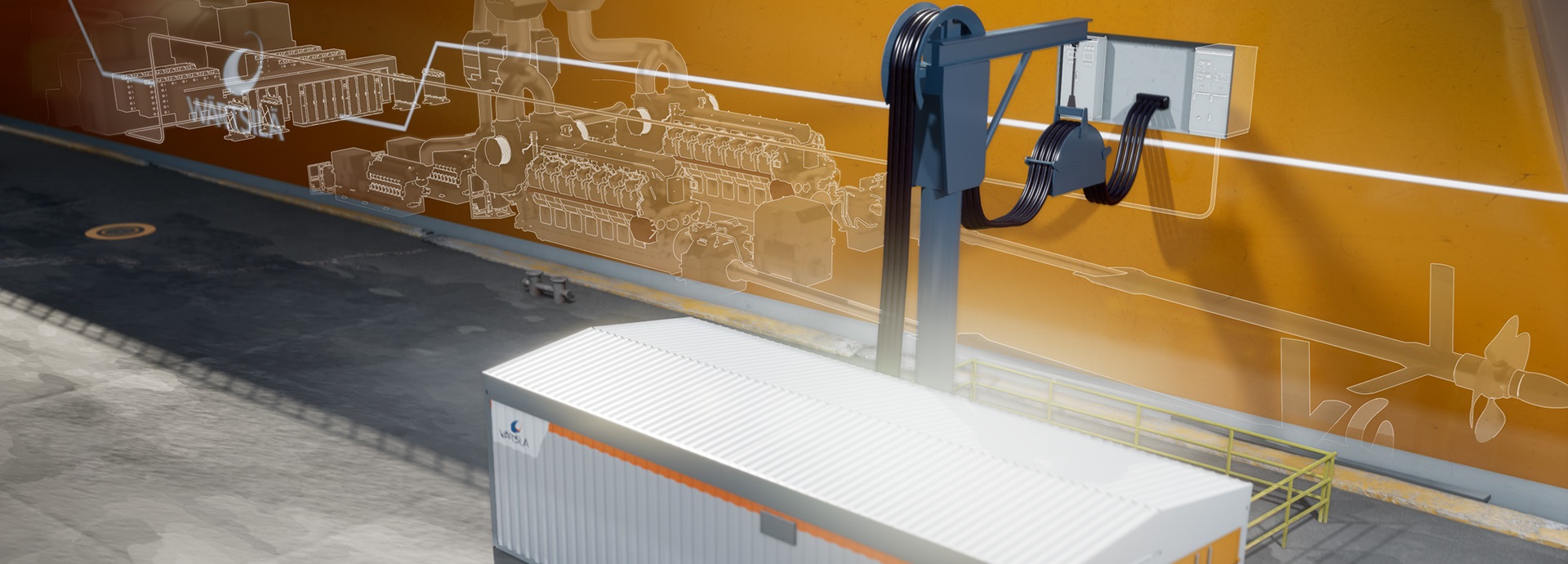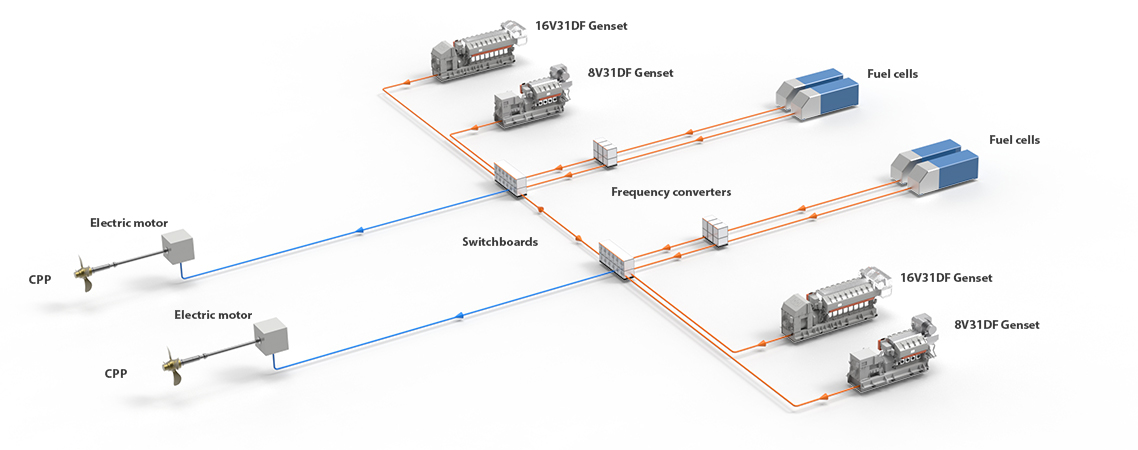

There’s more to electric shipping than electric propulsion
Electric shipping and hybrid ships are important solutions now that the marine industry has entered a new era – the age of decarbonisation and strict regulation. Vessels must be future proof: flexible enough to adapt to the changing needs in the future. As the regulation evolves and restrictions on emissions become stricter, the best way to stay competitive is to rely on the best available technologies. Electric shipping or ship electrification is one of the key solutions for marine decarbonisation.
The future of shipping is here: Play the video to discover how these interesting electrical solutions can reduce the environmental footprint for different vessels.
Electrical solutions and decarbonisation
Electrical solutions will deliver reduced emissions as retrofits and offer a competitive advantage also for newbuild vessels.
Electrical solutions have been part of vessel design for many years in the form of diesel-electric propulsion or shaft generators, for example. The share of green energy – from renewable sources such as wind, water, and solar – in land-based electrical grids is on the increase.
It makes sense for ships to take advantage of shore-based green energy. As an example, using a shore connection can reduce emissions significantly while the ship is in port. Depending on the vessel and its operating profile there are many ways to reduce its emission footprint. The key is optimisation: finding the right solution for each vessel.
Slow steaming used to be the favourite solution for many vessels to reduce emissions. Flexibility was not an issue then, so this means that some vessels will never be fully optimised. Electrical systems onboard make it possible to use smarter propulsion systems. Smarter, more resilient, and more flexible – and thus capable of adapting to the changing needs in the future of shipping.
What powers cruise ships in the future? Will cargo ship engines be electric?
Deepsea vessels will have to adopt green fuel engine technology to decarbonise. Electrical systems will be an integral part of the system including shaft generators and shore connection. Electric cruise ships and electric cargo ships are a futuristic concept, but they can go hybrid and take advantage of solar energy to improve their efficiency.
Tugs can benefit from hybrid or even full electric solutions. They operate close to the shore to land based electrical infrastructure. Because they have high load variations and spend long periods of time on standby, hybrid electric solutions will cut their GHG emissions significantly.
Ferries are often part of local transportation routes and can easily use the land-based charging infrastructure. If the route is short enough, the ferry can even be fully electric. Many ferries still prefer to have a hybrid electric solution to minimise risks.
Any short-distance or coastal vessel can be a hybrid ship. They can charge their ship battery with green energy available at the port. They can be a zero emission ship while manoeuvring, station keeping, and port navigating if they switch to full electric power during those operations.
Could you benefit from a hybrid solution?
Hybrid systems can be used on a wide variety of vessel types, both newbuilds and retrofits. Discover the clever ways that a hybrid solution could help you cut your vessel’s operational costs.
Battery-powered ships, hybrid ships or diesel-electric ships?
Which solution would be optimal for your vessels? The following are examples of actual solutions.
E&PMS landing page Solutions
Expand all
Why electrification – market trends and drivers
Watch the video and you will also learn three reasons to consider ship electrification as a solution for marine decarbonisation.
Solutions in more detail
Customer stories
Discover the benefits others have already gained from marine electric solutions.
Insights on electric shipping
Discover these insightful articles and case studies – they will build your knowledge of ship electrification and hybrid marine solutions.
Webinars related to electric shipping
Explore what you need to know about electric shipping and hybrid ships: watch the webinar recordings to learn from experts from the maritime industry and associations.
Hand-picked press releases
Wärtsilä propulsion package to power world’s largest methanol-ready cement carrier vessel
Technology group Wärtsilä’s focus on supporting the marine industry’s efforts to decarbonise operations continues to drive concrete steps forward. The latest order is to supply a complete propulsion package for a 38,000 DWT methanol-ready cement carrier vessel. When built, this will be the world’s largest vessel of its type, and the first with a methanol-ready notation. The order has been placed by NovaAlgoma, a joint venture between the Italian Swiss-based, Nova Marine Group and the Canadian Algoma Central Corporation. The ship is being built at the Zhejiang Xinle Shipbuilding Co.,Ltd, and is expected to be launched in late 2026. The order was booked by Wärtsilä in Q4 2024.
“This highly valuable new entry demonstrates the Group’s fleet development strategy and aims to address the significant increase in cement demand,” says Vincenzo Romeo, CEO of Nova Marine Group. “This will be the largest and most eco-friendly cement carrier ever built and is a tangible sign of our strong efforts towards a green fleet. Having Wärtsilä as the technology and solution provider supports our fleet’s effective transition towards decarbonisation.”
The Wärtsilä scope of supply includes two Wärtsilä 32 engines, one Wärtsilä 25 auxiliary engine, two gearboxes, two controllable pitch propellers, one tunnel thruster, three selective catalytic reduction (SCR) exhaust after-treatment systems, the propulsion control system, two shaft generators (PTO/PTI) and engine accessory items. The equipment is scheduled for delivery commencing in November 2025.
"Nova and Wärtsilä share a joint commitment to decarbonise shipping operations within the maritime industry,” comments Roger Holm, President of Wärtsilä Marine & Executive Vice President at Wärtsilä Corporation. “With this integrated package we are taking a holistic approach to the operation of this innovative vessel. This will allow us to support Nova with its sustainability goals around minimising emissions and ensuring the most efficient energy utilisation during operations.”
The Wärtsilä 32 engine is the result of the company’s long-established expertise. It is designed for efficient and easy maintenance in combination with long maintenance-free operating periods. It’s excellent fuel flexibility means it can easily be upgraded to operate with methanol. The Wärtsilä 25 engine’s modularity then offers maximised flexibility, while the engine’s efficiency and fuel economy deliver minimised emissions. In addition, Wärtsilä’s propulsion solutions deliver high efficiency, helping vessels to achieve their compliance targets. This is achieved in combination with a gearbox that reduces propeller speed meaning that a larger propeller diameter is utilised to maximise propulsive efficiency.
Media contact for more information on this release:
Isabella Alder
Positioning and Strategic Communications Manager, Wärtsilä Marine
Tel: +44 (0) 7792 681 757
marine.media@wartsila.com
Image caption:Wärtsilä will supply a complete propulsion package for a 38,000 DWT methanol-ready cement carrier vessel owned by NovaAlgoma © Wärtsilä Corporation
All Wärtsilä releases are available at https://www.wartsila.com/media/news-releases and at http://news.cision.com/wartsila-corporation where also the images can be downloaded. Use of the image(s) is allowed only in connection with the contents of this press release. Wärtsilä images are available at https://www.wartsila.com/media/image-bank .
Wärtsilä Marine in brief
Wärtsilä Marine is a global pioneer in power, propulsion and lifecycle solutions for the marine market. We develop industry-leading technologies, advancing maritime's transition to new fuels. We support building an end-to-end digital ecosystem where all vessels and ports are connected. Ultimately, Wärtsilä Marine is driving the shipping industry forward on its journey towards a decarbonised and sustainable future through our broad portfolio of engines, propulsion systems, hybrid technology, exhaust treatment, shaft line solutions and digital technologies, as well as integrated powertrain systems. Our offering, which is underpinned by our performance-based agreements, upgrades, lifecycle solutions, decarbonisation services, as well as an unrivalled global network of maritime expertise, delivers the efficiency, reliability, safety, and environmental performance needed to support a safe and sustainable future for our customers, our communities and our planet.
www.wartsila.com/marine
Wärtsilä in brief
Wärtsilä is a global leader in innovative technologies and lifecycle solutions for the marine and energy markets. We emphasise innovation in sustainable technology and services to help our customers continuously improve environmental and economic performance. Our dedicated and passionate team of 17,800 professionals in more than 280 locations in 79 countries shape the decarbonisation transformation of our industries across the globe. In 2023, Wärtsilä’s net sales totalled EUR 6.0 billion. Wärtsilä is listed on Nasdaq Helsinki.
www.wartsila.com
Take your easiest step on your journey to ship electrification - get in touch and let’s discuss your needs and options!



































